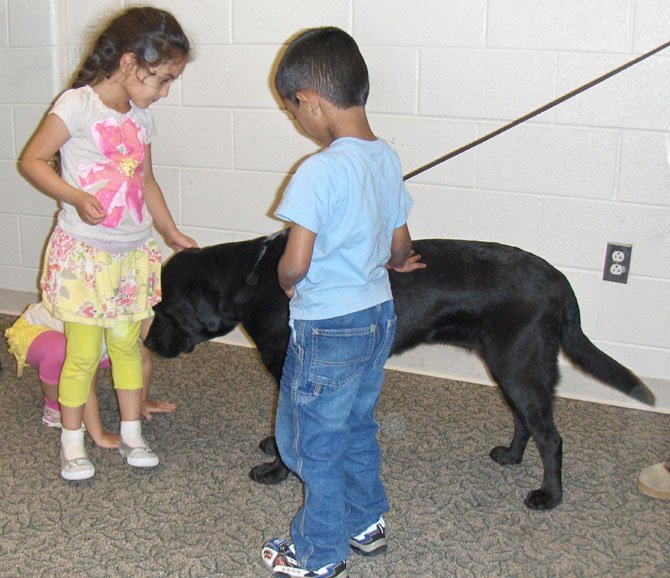Children make friends with K-9 Spicey during the meeting. Photo by Bonnie Hobbs.
Each month, members of the Sully District Station’s Citizens Advisory Committee learn about a different facet of the work done by the station’s police officers. In April, the topic was the bomb squad.
MPO Tom Eggers and MPO Bryan Cooke came to the CAC meeting with their K-9s, Moose and Spicey, respectively. And Cooke explained what the bomb squad does.
“We render safe IEDs and suspicious packages,” he said. “We’re also involved with the SWAT team, hostage negotiations and robot entry and search. We’ll search houses or vehicles and put a robot in harm’s way. We have several different robots for different types of searches and can even deploy weapons via the robots.”
Cooke said the bomb squad also does “explosive breaching” — using explosives to gain entry to, for example, a barricaded building. “We can also create a diversion for the SWAT team to be able to enter,” he said.
Added Eggers: “We make doors and windows where before there were none.”
And since bomb-squad members are also trained, hazardous-materials technicians, they also do HAZMAT monitoring. “We can send robots with equipment into a HAZMAT area to sniff it out and return to us with information,” said Cooke.
The squad also deals with the disposal of ammunition, explosives and ordnance. “We get rid of old bullets, weapons and, sometimes, an old grenade found in an attic,” said Cooke. “We get a lot of military ordnance; we even had to get rid of a live, Civil War cannonball.”
In addition, the squad helps the Criminal Investigations Bureau and Fire Marshal’s Office with investigations, upon request. It’s often called upon to assist in cases involving explosives such as bottle bombs. “We don’t do the investigations,” said Cooke. “We just provide the expertise.”
Sometimes, the officers are confronted with homemade explosives made in a laboratory in a resident’s home. In one instance, the bomb squad encountered nearly 3,000 pounds of fireworks in a Centreville home. (See sidebar).
Furthermore, said Cooke, “We get loaned to other jurisdictions because we’re part of the National Capital Region Bomb Squad. We’re one of the only full-time bomb squads in Virginia. We do K-9 sweeps and searches, and we’ve done operations in Washington, D.C., for the State of the Union. And for training others, we go all over the country; we teach citizens, government entities and other agencies and departments.”
The county’s police department has command responsibility in all bomb threats and incidents where there is no explosion. “If an explosion occurs, command shifts to the fire department,” said Cooke. “The fire marshal investigates the post-blast scene.”
The bomb squad currently has four, explosive-detection K-9s or “bomb dogs.” Training them takes about 16 weeks. “They’re trained to recognize over 19,000 different explosive odors,” said Cooke. “They’re food-driven and get food as a reward for work. They’re fed twice a day, and my dog’s trained to only eat his food from my hand.”
He said it takes six weeks to “imprint” a dog about explosives. “They learn the scents,” said Cooke. “Once a dog finds the problem, we’re already there to take care of it. It takes 10 weeks for us to learn to read the dogs, and they’re recertified every year to make sure we can always find what we want to find.”
“Bomb dogs are a search tool — only used to search areas for an unknown or unspecified threat,” he continued. “The ATF [Bureau of Alcohol, Tobacco and Firearms] gave us the dogs, but we work for them for five years at, for example, Super Bowls and political conventions. And we never jeopardize the dog’s safety, such as by putting him near a suspicious package. We have robots for that.”

